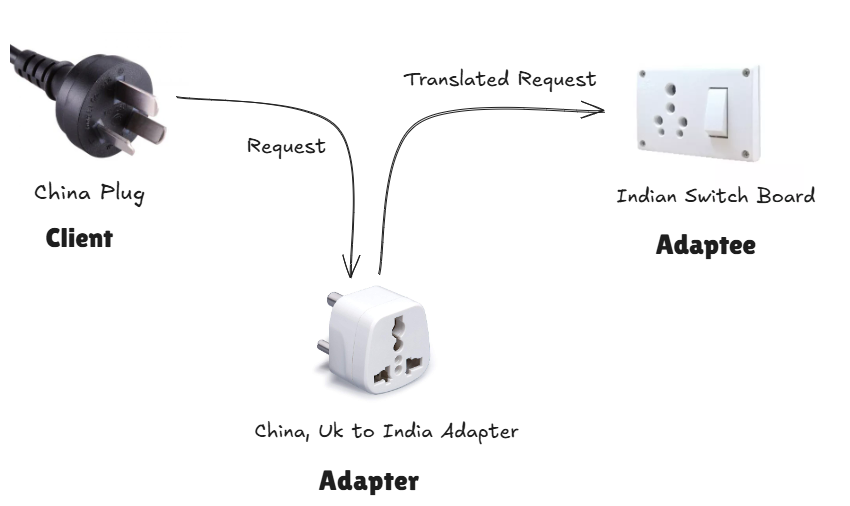Definition
The Adapter Pattern converts the interface of a class into another interface that clients expect. Adapter lets classes work together that couldn’t otherwise because of incompatible interfaces.
Real World Analogy
Imagine you bought a machine from China and imported it to India. The problem is that the plugs and sockets used in China are totally different from those in India. You still need to power on the machine, but you can’t simply connect it directly to the Indian socket.
Here the adapter comes into play. Instead of cutting wires and reattaching them to an Indian plug, you can use an adapter that converts the Chinese plug to fit the Indian socket.

Example of the Adapter Pattern to use a China plug with an Indian socket board.
Similarly, in our code example we have a Duck interface and implementations from the Strategy Pattern. We want to add a new bird type, Turkey, but also use the existing Duck interface without changing any existing code. As the Definition says, we can translate one interface to another without touching the existing implementations. Here, we’ll adapt the Turkey to behave like a Duck.
Design
classDiagram Concrete classes class MallardDuck { +fly() +quack() } class WildTurkey { +fly() +run() } class TurkeyAdapter { -turkey: Turkey +TurkeyAdapter(turkey: Turkey) +fly() +quack() } %% Relationships Duck <|.. MallardDuck Turkey <|.. WildTurkey TurkeyAdapter ..|> Duck TurkeyAdapter --> Turkey : adapts
Class diagram showing how TurkeyAdapter adapts a Turkey to the Duck interface.
Implementation In Java
Firstly, let’s look at the existing Duck interface and its MallardDuck implementation.
interface Duck {
public void fly();
public void quack();
}class MallardDuck implements Duck {
@Override
public void fly() {
System.out.println("Mallard Duck Flying");
}
@Override
public void quack() {
System.out.println("Mallard Duck quacking");
}
}The Duck interface defines two methods: fly() and quack(). MallardDuck implements these methods, providing the concrete behavior for a normal duck.
Next, we define the Turkey interface and its implementation:
interface Turkey {
public void fly();
public void run();
}class WildTurkey implements Turkey {
@Override
public void fly() {
System.out.println("Turkey Flying");
}
@Override
public void run() {
System.out.println("Turkey Running");
}
}The Turkey interface has two methods: fly() and run(). WildTurkey provides concrete behavior for these methods.
Since Turkey does not have a quack() method, we create an adapter to translate a Turkey into a Duck:
class TurkeyAdapter implements Duck {
private Turkey turkey;
public TurkeyAdapter(Turkey turkey) {
this.turkey = turkey;
}
@Override
public void fly() {
// Delegate the fly call to the turkey
this.turkey.fly();
}
@Override
public void quack() {
// Since turkeys don't quack, delegate quack to run()
this.turkey.run();
}
}TurkeyAdapter implements the Duck interface. It holds a reference to a Turkey object and delegates fly() calls directly, while quack() calls are mapped to the turkey’s run() method.
Finally, we put everything together:
public class ObjectAdapterDemo {
public static void main(String[] args) {
// Original Duck
Duck duck = new MallardDuck();
// Adapted Turkey
Duck duck2 = new TurkeyAdapter(new WildTurkey());
duck.quack();
duck2.quack();
}
}Output:
Mallard Duck quacking
Turkey RunningClass Adapter
The above example uses the Object Adapter approach. You can also implement a Class Adapter when the language supports multiple inheritance. Java does not allow multiple class inheritance, but you can achieve similar behavior using multiple interfaces. In languages like C++, you could directly inherit both the target interface and the adaptee.
Real World Example
A classic example in Java is InputStreamReader:
public static void main(String[] args) throws FileNotFoundException, IOException {
String path = System.getProperty("user.dir");
path = path.concat("/src/adapter/file.txt");
File file = new File(path);
// Adaptee: byte-based API
InputStream fileStream = new FileInputStream(file);
// Adapter: converts bytes to characters
Reader inputStreamReader = new InputStreamReader(fileStream);
// Client: reads text lines
BufferedReader reader = new BufferedReader(inputStreamReader);
String line;
while ((line = reader.readLine()) != null) {
System.out.println(line);
}
reader.close();
}Why it is called an Adapter?
- Adaptee:
InputStream(byte‐based API). - Target Interface:
Reader(char‐based API that many APIs expect). - Adapter:
InputStreamReaderextendsReaderand internally holds anInputStream, delegating calls and translating bytes into characters.
Whenever you need to feed a byte[], a Socket.getInputStream(), or a FileInputStream into a component that only accepts a Reader, you’re using the Adapter Pattern—straight out of the core Java I/O library.
Design Principles:
- Encapsulate What Varies - Identify the parts of the code that are going to change and encapsulate them into separate class just like the Strategy Pattern.
- Favor Composition Over Inheritance - Instead of using inheritance on extending functionality, rather use composition by delegating behavior to other objects.
- Program to Interface not Implementations - Write code that depends on Abstractions or Interfaces rather than Concrete Classes.
- Strive for Loosely coupled design between objects that interact - When implementing a class, avoid tightly coupled classes. Instead, use loosely coupled objects by leveraging abstractions and interfaces. This approach ensures that the class does not heavily depend on other classes.
- Classes Should be Open for Extension But closed for Modification - Design your classes so you can extend their behavior without altering their existing, stable code.
- Depend on Abstractions, Do not depend on concrete class - Rely on interfaces or abstract types instead of concrete classes so you can swap implementations without altering client code.